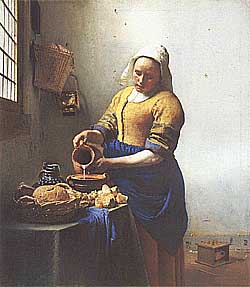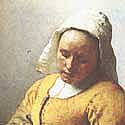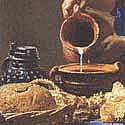
Milkmaid, 1658 - 1660 *

Milkmaid, 1658 - 1660 *

Use what talents you possess;
the woods would be very silent
if no birds sang except those that sang best.
~ Henry Van Dyke
As soon as man does not take his existence for granted,
but beholds it as something unfathomably mysterious,
thought begins.
~ Albert Schweitzer

Windmills Reflected, Kinderdijk, Netherlands
Make yourself an honest man,
and then you may be sure that
there is one less scoundrel in the world.
~ Thomas Carlysle


* One of the most famous paintings is probably the Milkmaid in the Rijksmuseum in Amsterdam. The milkmaid, wearing colorful clothes, stands out against the relatively neutral wall without paintings or maps. Vermeer has used very bright colors to emphasize the milkmaid. The yellow, blue and red in her clothes form a very beautiful and bright unity. Also the white cap, covered in sunlight, is highlighted. On the table, in the left front corner, we see food. We see how the milkmaid pours milk from a jug into a bowl. The milkmaid is completely focused on her work and doesn't seem to realize that she is being painted. Quite often, Vermeer painted these daily, dominical scenes this way. An exception is, for example, The girl with the wine glass, in which the young woman looks directly at the painter. Yet, this painting was not meant to have such a peaceful atmosphere. Research has shown that Vermeer removed several details to create a more serene atmosphere. For instance, there first was an object on the wall, maybe a map or a painting. There also was a basket filled with laundry at the spot where we now see a foot stove. Vermeer replaced this detail. The foot stove is particularly remarkable. Why does this object have a relatively central position? Vermeer could have left the space to the Milkmaid's right open, for we do not really get the impression that the foot stove contributes anything essential to the painting. Vermeer has placed a foot stove here because of the symbolic meaning of this painting. Let's look at the iconography. The laundry basket, as depicted by Vermeer in the painting's first form, clearly refers to the function of kitchen maid. A kitchen maid did not only take care of food and drinks, but also performed a large number of dominical tasks. The laundry basket is a symbol of these tasks. Yet, Vermeer chose to replace the laundry basket with a foot stove. But why did he choose a foot stove? We can find the answer in a so-called 'Embleemboek'(Emblem book) from the seventeenth century. The function of the foot stove was to warm women's feet in the winter. (One could put some hot coals inside the foot stove). The foot stove should therefore be seen as a symbol for warmth, love and loyalty. This symbolic meaning becomes even clearer when we look at the tiles in the background, on which we see small Cupids. These little cupids, too, refer to love and warmth. What consequences does the meaning of the tiles and the foot stove have for the meaning of this painting? We can speculate about this. Maybe the maid needs personal warmth and love, for she sacrifices herself to serve her employers. Or is this painting about the love and warmth that she receives from her employers? Maybe she has warm feelings for a boy next door, or even her boss! Perhaps this painting merely expresses a very general concept: giving or receiving love and warmth. In any case, this quiet, serene painting turns out to have a very warm or even passionate deeper meaning.